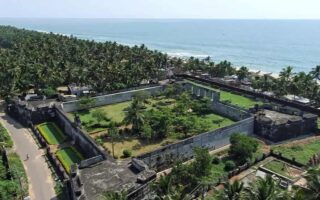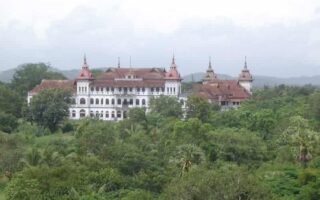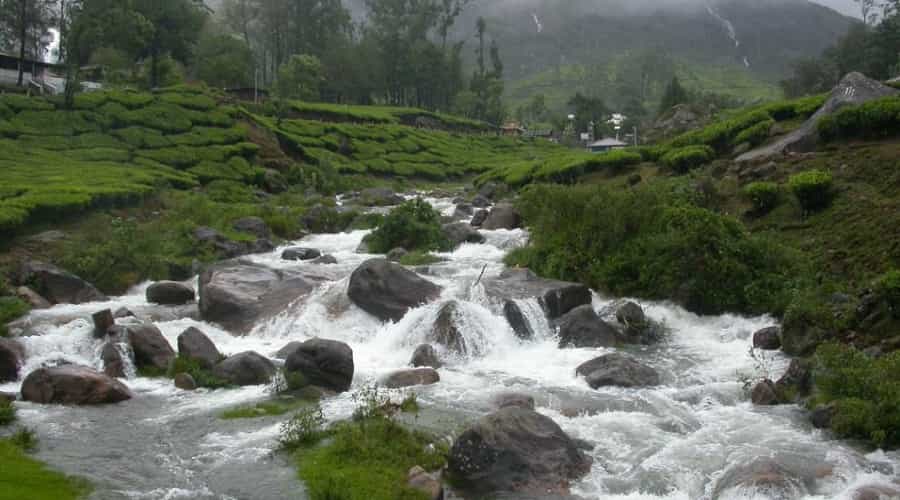In India, the major differences between the states can be seen in different aspects like cuisine, Language, Music, Costume and Dance. The state of Kerala is known as a destination for tourists to know the culture of India’s southern part. Kerala has still preserved their traditional culture, custom, language, food culture, music and dance forms. There are a number of dance forms which are practiced by the people of Kerala state. All their different dance forms are very popular in the whole country and also in other nations. This state has a very rich tradition and culture of the dance forms; which display the temperaments and moods of the different religious stories and epics with bright and beautiful traditional costumes.
Their number of dance forms are categories in the different parts like Tribal dance, Neo classical dance, folk dance, Modern dance and Classical dance. The dance also includes the various types of music forms. From olden days, music is a lifeline of Kerala’s people. Till today, they have preserved their rich and precious music culture and are practicing it. The presence of classical music can be found in each and every home. The regional people have completely devoted themselves to the folk music, on each occasion they require folk music or songs. Kerala’s traditional music is an identifiable flavor of this land and it is beautiful. The folk songs are the prime source of entertainment for regional people and especially for the villagers. The major forms of Kerala music are Carnatic music, folk music, work song, Kathakali music, film songs, Lullabies etc.
Kakkarissi Natakam
- Theme of: Lord Shiva and Mother Parvati’s historical stories.
- Famous for: Kerala state’s oldest theatre Form
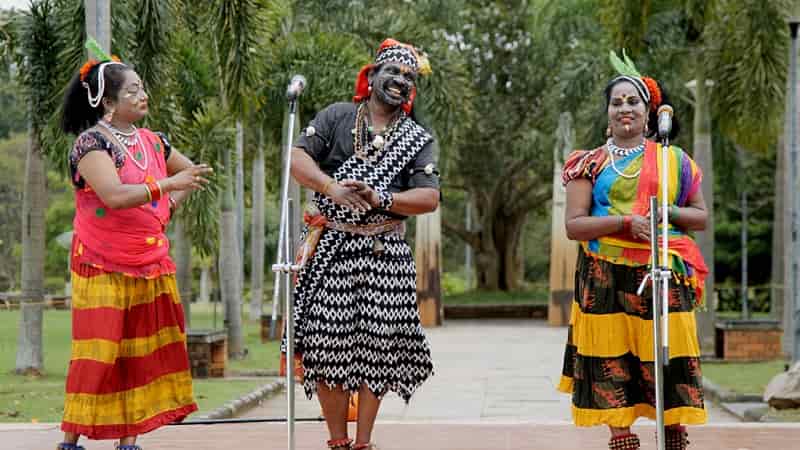
This dance form of Kerala state is a cynical which is based on Hindu mythology’s characters. This is a very unique and different dance form of Kerala. This dance form is performed on the contemporary themes; they display the Hindu mythologies characters. The whole dance form depends on the stories belonging to mythology. There is a belief that the Mother Goddess Parvati and Shiva were concealing them in Kakkathi and Kakkalan. These were the traditional tribes that were very popular for the telling People`s future. Only this much is taken from the mythological Hindu legends to perform and the rest of the performance is performed on the contemporary topics. Because of the involvement of contemporary topics, this dance form is accepted and enjoyed in this current century. The major characteristics of this dance form are Velichappadu, Kakkalan, Thampuran, Vetan and Kakkathi. This dance type is performed with the rhythmical music which is created by the Chenda, Dholak, Harmonium and Kanjira etc instruments.
This is a very traditional dance type of Kerala state; this has been mixed with the modern society and the issues which are displayed through the dance that are taken from Hindu religion’s puranas. The song which they use in this dance form is a mixture of Malayalam and Tamil Language.
Chakyar Koothu
- Number of Performer: Only one person
- Place for Performance: Temple of Koothambalam
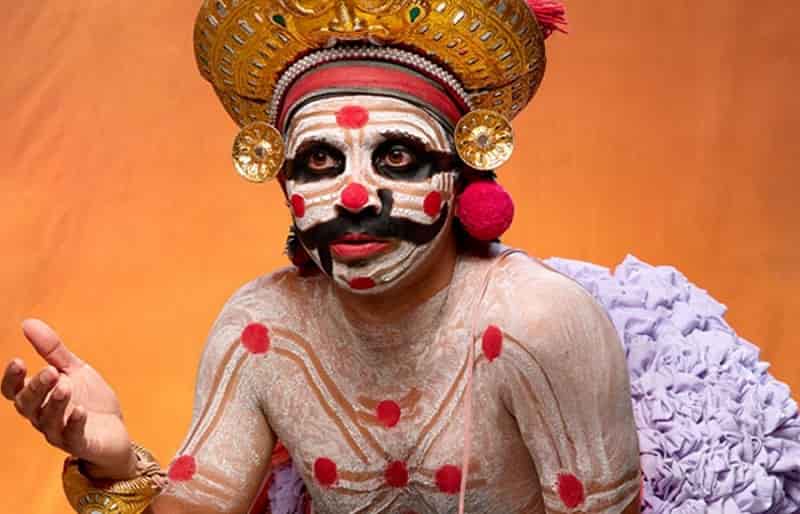
This dance form is very religious and a social dance art. This dance type is present in the Temple of Koothuthara or village of Koothambalams. They perform this dance individually or being a Kootiyattam’s part, mean this Chakyar Koothu is performed by only one character which is called as a Chakyar, this makes the performance interesting by doing comic acting and mimicry. The character called Chakyar plays the role of a joker or called as Vidushaka, who makes the People laugh.
By acting, he displays the stories of the famous historical epics. He narrates the epic character and their behaviour in a funny way. Audience just can’t stop laughing over his fun act. He enacts the whole story in a funny way. The performs the whole act on a musical rhythm which is created by using Mizhavu musical instrument.
Kalamandalam Dance
- Region: Thrissur town around thirty two kilometers.
- Started in: 1927
- Started By: Poet Vallathol
- Unique Feature: School of Kathakali.
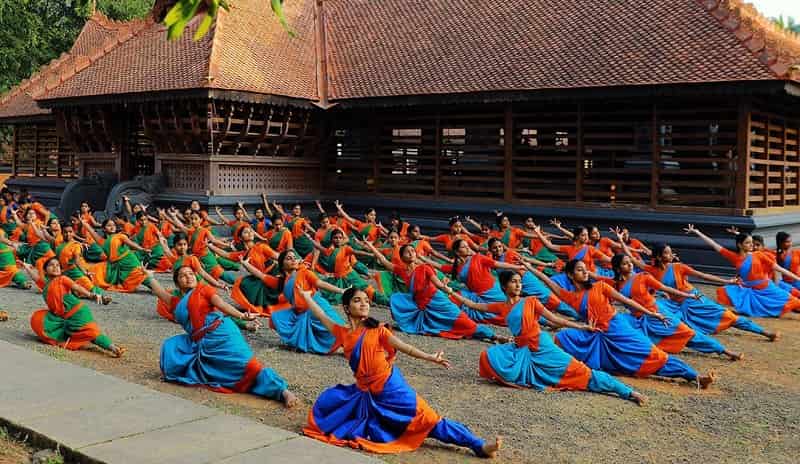
Earlier, the name of this dance form was different, after some time it as renamed by the name of Kalamandalam, it is a university which teaches the Culture and Art. It is main point, where people come to learn the India’s performing art, and mostly those arts which are established within India’s southern part, by giving special preference to the Kerala state. The university is located in the Cheruthuruthy village which is in the district of Thrissur. This district is located on the river of Bharathapuzha. Earlier it was only an institution but now it became a university, which was started by the great poet Vallathol Menon in the year of 1930. There was one more person who contributed to start this university is Manakkulam Raja. This performing art university gives classical dance training and also the theatre performing arts such as Thullal, Koothu, Mohiniyattam, Bharatnatyam, Kathakali, Kuchipudi and Koodiyattam etc rather than Kerala’s traditional musical orchestra which is known as a Panchavadyam. In Kalamandalam University, they give training with the company of different musical instruments such as Mizhavu, Chenda and Maddalam. This university believes in the ancient times traditional teaching system means Gurukula system. In the ancient time, students used to stay at the teacher’s place and learn the things, it was an excellent training system. This university is following that which is not in practice now days. Because of this system, the bond between the student and teacher becomes very strong and students were able to live under the guidance of the teachers. Notable teachers or guides are there in the university.
The beginning of this university had been given the new life to the main Kerala’s performing arts like Mohiniyattam, Koodiyattam and Kathakali after the completion of twentieth century. These performing arts were going through by the rule threat which was made by the colonial authorities. During the 1927, in this year Mukunda Raja and Vallathol Menon took the initiative and decided to form the society named as Kerala Kalamandalam. They collected the donation from the people and they organized the lottery to build the funds which they are going to use for the society. The inauguration of the society was done in the year of 1930 November at the place of Kunnamkulam. After some time, university was placed in the Cheruthuruthy village. The king of the Cochin region gifted the building and land to the university. The department of the dance of this university gave the second life to the Mohiniyattam dance form. In the year of 2004, to promote and develop this university, UNESCO gave the financial assistance to the university. Kalamandalam University is the single performing art university which has still maintained their status and prestige through their work and education.
Koothu Dance
- Region: Kerala State
- Themed On: Lord Krishna’s Life
- Present By: Chakia community’s women
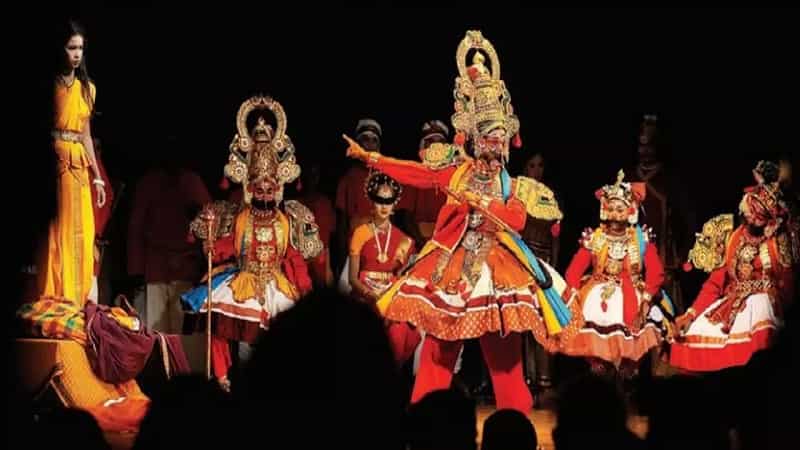
Koothu dance form is very much major dance form of the Kerala state. This is a solo dance form, only single person perform this dance form. This dance not only contain dance but it also contain acting. This dance is as per the mono act or comedy act. Koothu dance is majorly present by the Chakyar caste’s people. It is present within the temple by the Koothambalam. This is very ancient dance form. it was theatrical art form, which required strong gestures and expressions as per the character, the principles of this dance form are linked with the principles of the Natya Shastra. By this dance performance, the performer has to embarrass the watchers with the smart way. As per the most of the Kerala state’s dance form, this dance is also theme based which they takes from the ancient epics stories, these stories are available in the Sanskrit language. But for the performance artists translate it in the Malayalam language with the help of movements of body on the rhythm of Tandava dance and the Natya Shastra’s expression.
The name of the dance form Koothu, the actual meaning of this word is dance. This meaning is may be assumed but in real this dance form required less choreography. Even if the dance movements are less but expressions are very much essential because only on expression, this dance form entertain the audience. Mesmerizing the audience only by the facial expression is very difficult task for the performer. The performance of this Koothu dance is starts by the prayer. After that, the artists display some part of the theme in the language of Sanskrit and after that he describes it in the Malayalam language also so that audience will understand the meaning. While the performance, the artist showcase some subjects like event of politics, recent events, social events and many more. To show this entire real event, the performance requires humor. Koothu dance’s narration part contains dance step which is normally used on the occasion and different gestures.
For this dance, artist wore very unique attire, which includes different types of headgear. To make the performance bright and attractive, they apply special makeup. For the rhythmic musical background, they use instrument like Mizhavu, it is like a cymbals and big drum. This musical instrument is played by the person of particular caste that is Nambiyar. In the normal intervals, the females play it which is called as Nangiyars. If this dance form is present by the Chakyar, then the dance is known as a Prabandha Koothu. When it is danced by the Nagiyar females, then it is known as a Nangiyar Koothu. This traditional dance form is still practiced in some shrines of Kerala state such as Lord Krishna temple in Ambalappuzha, Vadakkunnatha shrine it is at Thrissur, Kumaranalloor shrine in Kottayam and at Irinjalakuda, the shrine of Koodalmanikyam. Koothu dance is not performed at the outside of temple. the very famous performer of the Koodiyattam and Koothu dance Madhava Chakyar was tried to take this dance outside the temple, but at that time many artists opposed him and did not help him. But Madhava Chakyar took the responsibility and he perfumed it. Example of this great artist gave an inspiration to shoe their talent; after that incident he did performance of Koothu dance on the stage.
Theyyam
- Famous Within : Kerala’s Northern Part
- Also Known : Kaliyattam
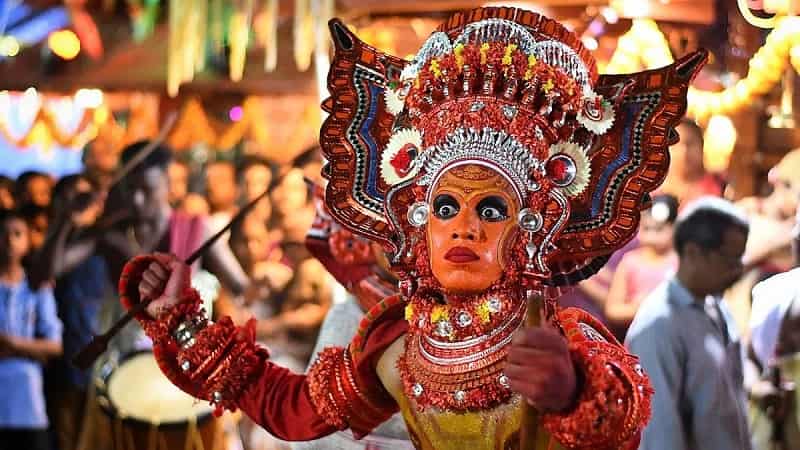
This religious dance form is majorly performed within the region of Malabar and also in Kerala’s northern part. The district Kolathunadu is very much popular for this dance form. The name of this dance form Theyyam has been come from the word Deyvam, the meaning of this is God and the meaning of Attam is Dance. This is actually a breathtaking dance which was done by the Gods. This dance form is also famous by the name of Thirayattam or Thira within the region of Malabar’s southern part. This is very much huge spiritual art form which is present in the Kerala with great enthusiasm and large excitement. The performer actually feels the divine power of the God, while performing the form. This form is also called by the name of Kaliyattam.
Within the festival such as Kottams and Kavus, Theyyam dance form is present by the dancers. These two festivals have been organized during the month of November and month May. Within the courtyard of the temple Parassinikkadavu, which is close to the town Kannur, this dance has been present. During the whole year, this dance has been present. There are also some numbers of the temples in Kerala, where this dance form has been performed such as Kurumathoor, Karivalloor, Ezhom, Parassini, Kunnathoorpadi, Nileswaram and Cherukunnu etc. there are some towns in Kerala state, where Theyyam is a major dance form like Muchilottu, Pottan, Bhagavati, Raktha Chamundi, Wayanadu Kulaveni, Kari Chamundi and Gulikan. Around four hundred Theyyams performances are done in single Kerala state. This dance is performed by Hindu religion’s lower caste, there is one major deity which has been present through the different ways like Bhagavathy and Bhadrakali etc. This dance form is actually use to call the dead people or fore fathers. The performers of the dance present this dance at the front place; the performers come from the different castes such as Malayan and Vannan. When the dance is going to start the starting ritual called as Thottam and Thudangal are performed as per the customs.
The most unique and attractive characteristic of this form’s dancers is their decorative make up and also attire. The paintings done on the body and face are very beautiful. Within the, make up decoration of the eyes is very essential thing. They use black make up to show the scary eyes. For the highlighting the painting of face and eyes they draw bold size stroke. To do the entire body make up, it requires very much time. The artists give permission to paint his whole body and face. The color shades which they majorly use are white, yellow, orange and black etc. Different colors are used to highlight various features of the character. They also wore the head gear as an accessories, it is designed by using the palm leaves, cloth, feathers of coconut bird and also flowers.
Velakali Dance
- Region : Kerala State
- Belongs To : Kerala’s Southern Part
- Present By : Warriors of Nair Community.
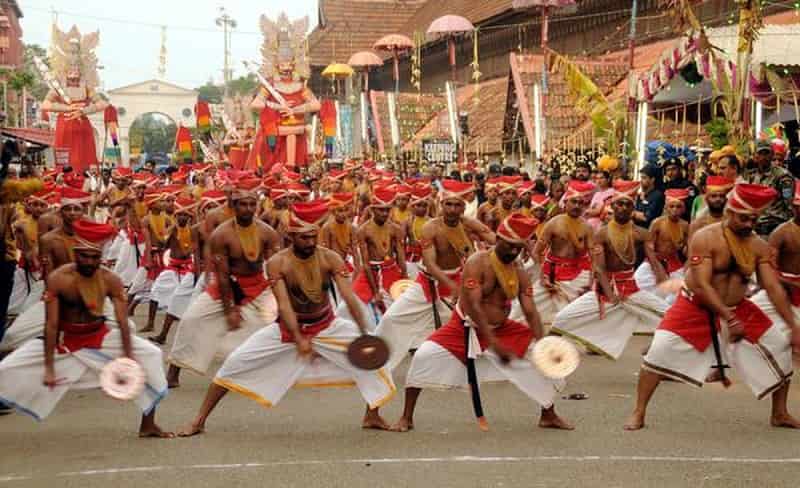
In the entire Kerala state, you won’t get to see any other dance form like Velakali dance, because it is totally different and unique dance form than other dance types of the Kerala. This is martial art dance type. This dance is usually performed by the Kerala state’s southern region and by Nair community’s warriors. In this performance, they use props like shields and swords. This dance form had been generated in Kerala’s Ambalappuzha. At this place Chempakassery army’s leader Mathoor Panicker started promoting this dance form, because he wanted to the give boost to the art of martial skill which are present in the people but yet not developed. Lord Krishna’s temple which is located at the Ambalappuzha, this temple’s major attraction is Velakali dance form.
All the performer artists of this dance form are belongs to the community of Nair. For the rhythmic interest, they use Kombu, Maddalam, Kuzhal and Ilathalam all these musical instruments. The performers wore their traditional attires, they also use headgear which is very colorful, this type of headgear was using in the medieval period by the soldiers of Nair community. They hold the different weapons like sword in the hands and with these things; they perform the martial art dance. Some dancer artists hold the musical instruments also.
Tholpavakoothu Dance
- Present At: District Palakkad’s annual festival
- Meaning: Play of Leather Puppet
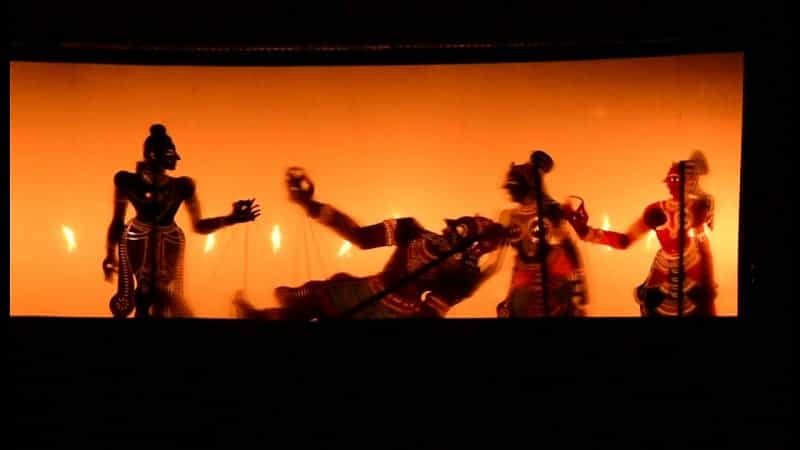
The actual meaning of this dance form’s name is play of leather puppet. In this name Tholppavakoothu, Thol is a name of local language, meaning of Koothu is Play and Pava is leather. This is a religious dance art form which is present while each year’s festival which is organized in the temple of Goddess Kali, it is located at the district of Palakkad. The theme of this dance form is based over the Kamba Ramayana. This play is narrated by the artists in blend on two languages Tamil and Malayalam. As per believe of the local people, some mythological stories were generated from the historical art type. As per the theme, in the ancient time, Lord Rama killed the Ravana, and brought Sita back. At that time, Goddess Mother Kali was on the task of destroying the devil called Darika. The reason behind that was, Goddess Kali could not take a part in the war against Raavana, but because of Darika. When she killed at devil, her wish was agreed by the Lord Shiva and he got the opportunity to participate in the huge fight. From that ancient moment the traditions of this dance form begun. Within the district of Palakkad, this traditional dance performance has been practiced in the Kali temple. While the Kerala’s festival Poorams also this dance has been performed.
In the twelfth century, a very great Kambar poet written the Kamba Ramayana and from this Tamil literature, scholar Chinnathambi Vadhyal created this dance form’s script. This dance art form depicts the whole Ramayana, he has narrated it in around twenty one sections and for the one performance of this dance, it requires almost twenty one nights. Because this is a puppets dance form, then it requires about three hundred leather puppets to perform whole dance form. They arranged the performing stage by using the curtain of white color and the puppets which are used are managed with the help of sticks, those sticks are attached with the screens behind part. For the screen’s shadow, they kept traditional oil lamps on the back side of the puppets.
This dance form is companion to the art forms such as Theeyattu and Mudiyettu. These types of ritual art forms are actually served to the God. They also organize the dance play on the theme of Mahabharat and the other ancient stories. Now days, there are very less numbers of dancers are available who perform this dance form. In Kerala state, now only one group has been left who organize the play of Tholpavakoothu dance, it is Krishnankutty Pulavar. This dance group also has the membership of other organizations such as UNIMA, this is Puppeteers organization, and it is international. The themes, which are expressed in through this dance art form are narrated by the blend of Malayalam and Tamil language. For the musical background, they use instruments such as Elathalam, Chenda and also Ezhupura etc.
Sarpam Thullal
- Present By: Community of Pullavans.
- Present to Pacify: Goddess Snake
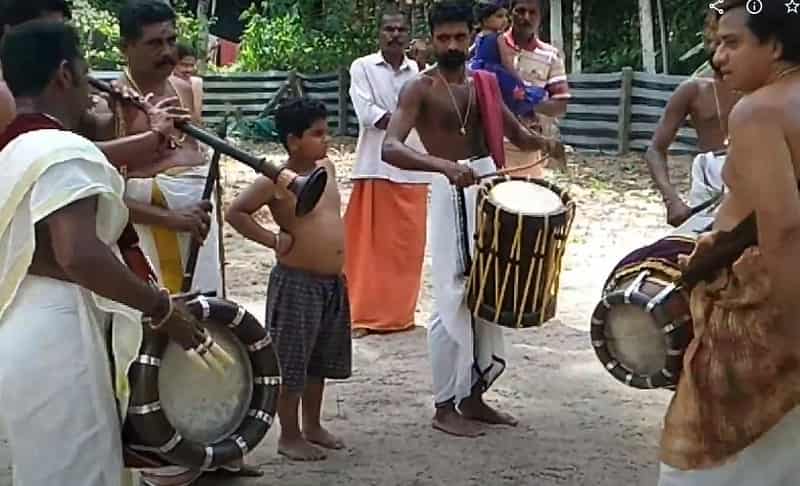
This dance form is a spiritual form, which is offered to pacify the Snake deities. This dance form is performed in the central region of Kerala. In the early period, houses of families which were located in the Kerala state, had a belief towards the shrines of snake, which is known as Kavu. This dance form is generally performed in the courtyard of the house, where many shrines of the snakes are found, that’s why they are performed over there. The prayer behind worshipping deity snake is to have, wealth, happiness for the whole family. As per the other dance forms which are specifically performed by the particular community. Sarpam Thullal dance form is also present by particular people’s community which is known as a Pulluvar. Before starting the dance performance, Pulluvar People make a kalam, which means a field. At that place they keep 2 or more snakes. After that they start their traditional oil lamp and they keep rice in that field, where the snakes are placed. After completing this first step, they bring the idol of the deity snake in the column, which is known as Thalapoli. With the musical background of Panchavadyam instrument.
After bringing that idol, they keep it in the kalam, the religious person which is called as Pujari does spiritual customs, at that time, and all the girls sit around the Kollam. After completing the rituals, Pujari start performing the dance around the Kolam on the music, generated by the Elathalam and Para. The men singers are known as a Pulluvan and the women singers known as a Pulluvathi, these singers’ starts singing their religious song during these rituals. For the musical rhythm, they use their common instruments such as Pulluvan Kudam and veena, it is known by the name of nanduni. When the rythm of the music increases, all the females’ start dancing.
Margam Kali
- Themed On: St. Thomas’s life
- Present By: Kerala’s Syrian Christian
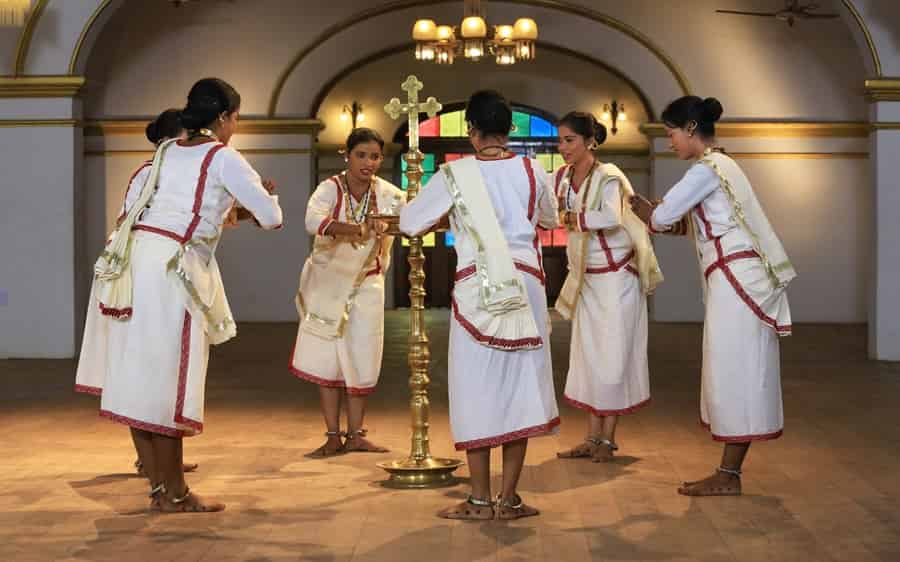
This dance form is very historical and famous dance form which is very common in the Syrian Christian people of state Kerala. The name of the dance form Margam Kali, Margam word’s roughly meaning is ay, creed or religion and path. There is saying that this dance was progressed by the Kalaripayattu. Syrian Christian people say that this dance form is used to grow their religion Christian. It is spiritual dance form; this dance performed by almost 12 numbers of artists. They dances round which they make around the oil lamp which is traditional ritual of their. Through this, they display 12 churches Dom and one lamp is display the Christ. To perform this Margam Kali dance, the dancers wore their traditional dhoti in white color and also the feather of peacock, which they attached on the turban. With this dance form, they also use their traditional text. This text is offered in fourteen strophes and it has around four hundred fifty lines. This traditional song is very much older; it has been made before the invasion of Portuguese empire within the Kerala state. Even if this dance form requires song, still it does not perform on any type of music. The song on which this dance form has been performed is an interpretation of the great St. Thomas’s work, in the region of Malabar and also St. Thomas’s martyrdom. Margam Kali dance is an art form. As per the other dance forms of the Kerala, this dance form’s song is also performed by the Asan of the dance group means leader and the other artists are also singing with the leader. Through the narration of the performance, you will come to know the affection in the Malayalam and old Tamil language.
As per the change of time, there are many unique songs also combined in their traditional song; this traditional song is written in the pure Malayalam language. After the dance and song, they show the martial arts with shields and fake swords. The very much known Parichamuttukali martial art is generally showcased in this dance performance. As per the tradition, in the earlier time this dance form had been helped to the soldiers of Christian religion. Now days, Margam Kali dance is became mandatory in every marriage and other occasions of the Syrian Christian people. For the Syrian Christian people who live in the Thrissur and Kottayam district, Margam Kali dance is very much popular and important. As per the tradition of this dance, this is only presented by the males but from the recent year, it is also done by the females in competitions of school and stage.
Mudiyettu
- Known For: Goddess Victory on the Demon Darikan
- Present At: Goddess Kali’s temple
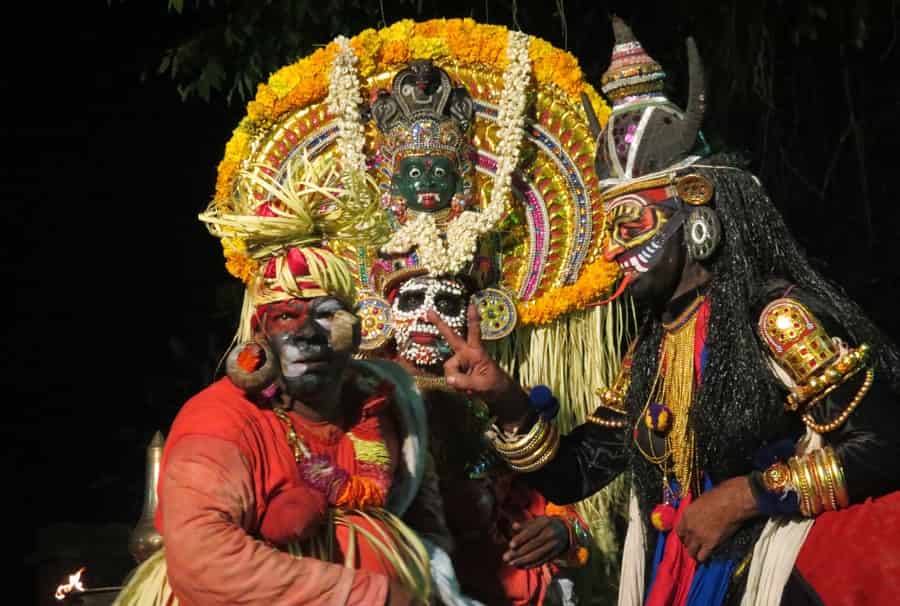
This dance form is a spiritual dance which present within some of the temples of Goddess Kali, situated in the districts like Kottayam and Ernakulam. This dance is sign of victory of Goddess Kali on the Darikan demon. This form has been present by the people like Marar or Kuruppu which derive the community of temple bound of the state Kerala. Mudiyettu is one of the forms of worshipping to the Goddess Mother Bhadrakali. There are different styles in this state of worship. Lord Shiva’s manifestation is Goddess Bhadrakali. Before the establishment of shrine, this dance form had been started. This is just not the worshipping of the Goddess or God; it is an art which gives opportunity to worship their respectful God. Lots of art forms are already removed. Only Mudiyettu and some other worshipping art are still in practice. This dance form is spiritual entertainment for the people who come to visit the God and for Goddess Kali; it is a form of praying. There is not a real record which can describes the actual time or century of this dance form. The artists of this dance wore the attires like headgear made by wood and also the important mask which signifies the Goddess Kali.
This dance is all about the fight of Goddess Bhadrakali with the 2 devil or Asuras, they were irritating the mankind and Devas. Their fight was finished by when both the devil were killed by the Goddess. As per the other dance forms, there is no such gesture and facial expressions are used, all these are applied in the other worshipping dance form. In the starting year of the Mudiyettu, it was performed with the speech. After some year, rhythmic steps were adopted by them on the place of speech and dance. Many people and also God liked the new format of this Mudiyettu dance. This dance becomes interesting and exciting, when watchers also take a part in the performance of this form. One character of this dance known Kooli is creates the dance funny by the comic action and speech. Like this character, you won’t get to see in other worshipping art forms. The starting sequence of this dance form is also little bit unique than other art form. This type of art form, worshipping got a new way.
Padayani
- Present By: Nair Community
- Organized at: Temple of Goddess Kali
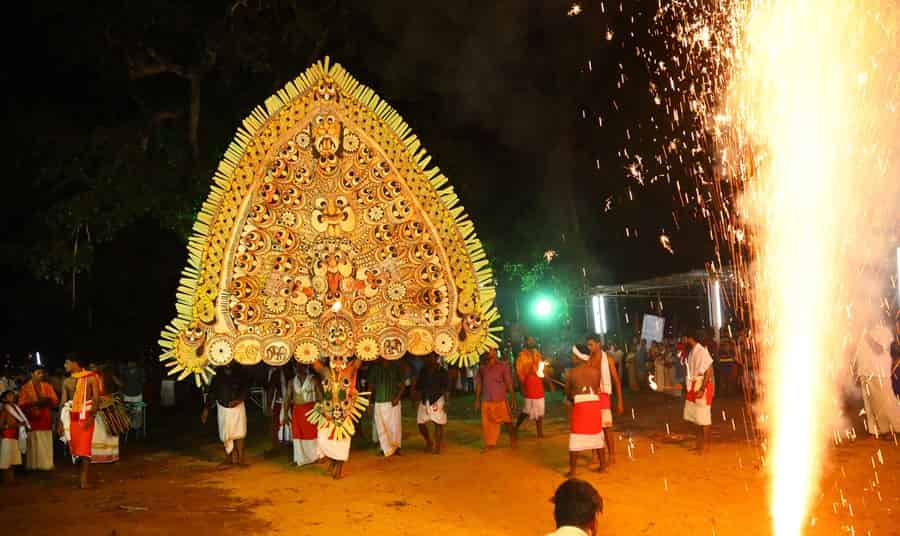
This is very famous dance form which some under the category of spiritual art form of the Kerala state. The duration of this dance form is almost a whole week, which they organized at the temple of Goddess Kali, which is situated at the Pamba River’s bank. This dance is performed in the month of Malayalam called as month of Meenam and month of Medam means March and April. This dance form is related to the temple of Goddess Kali on the area of Central Travancore. Majorly the theme of Padayani dance is battle of Goddess Kali and devil Darikan. Through this dance form, dancers criticize the other different communities and groups, just by doing different expressions and gestures.
In Padayani dance, the dancing movements are distinctive of every character; they called Kolam to mean character. The key figures in this narrative include Yakshi, Kalaari, representing Lord Shiva, Bhairavi, symbolizing Bhadrakali, and Pakshi, signifying a bird. All the dancers use costume like Kolams and they show the situation of killing the devil. For the musical interest, they use musical instrument called Thappu and also some Chendas. The dancers decorate themselves with a very attractive way. They wore the colored masks with the unique and different images. When you will attend this dance, you will defiantly surprise by seeing the ears in triangular shape, bizarre size of headgear and big circular eyes, through this accessories, they create real image of the battle. This dance form is present by the lots of energy and boost, with this enthusiasm, they performed dance in numbers of village temples. Because of this type of religious dance performance, villagers also get fun and they also came to know the ancient moments.
Theeyattu
- Majorly Present at: Pallippurathu Kaavu
- Present By: Communities of Unnis group
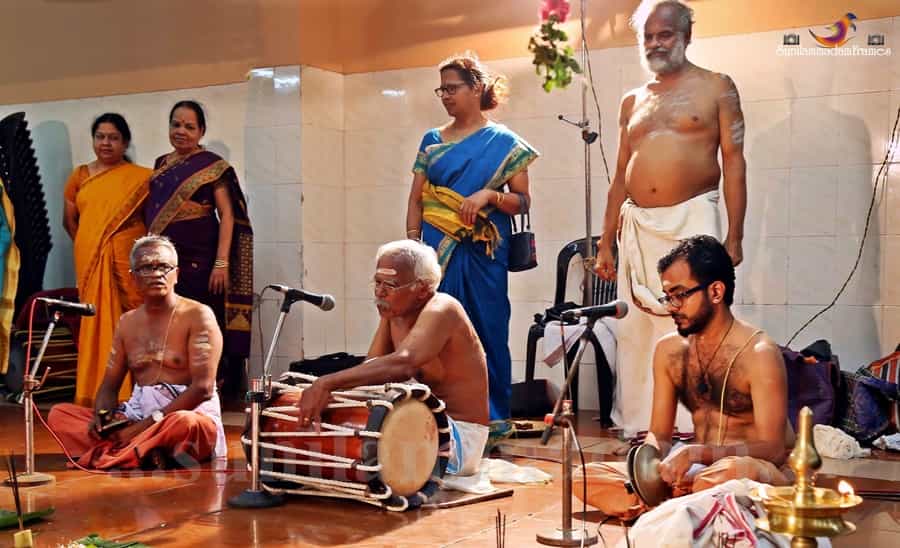
Each and every dance form of the Kerala State is unique and different from each other; this aspect of Kerala state makes this place full of variety tourists’ destination. Like Theeyattu dance form is also different from other dances, this is very religious dance forms. This is a ritual art of Kerala state. This dance form is normally present in the temple of Ayyappa and also the Bhadrakali. This is very much famous dance art form of this state. This is a spiritual art form because the meaning of the name of the dance form Theeyattu is God. Distinctiveness of this form is, only one dancer presents this dance, which is known by the name of Theeyattuni. For the performance, the artist does the get up of Mother Goddess Bhadrakali and whiles the performance they also does some mantras for the happiness of the front of the audience. During the Theeyattu dance performance, at the certain point when the artist does headgear, they have believe that, at that time, that artist is God. This ritual dance depicts the fight of devil Darikasura and Bhadrakali, in this war, in the end Mother Goddess Kali killed the devil. There are some dance movements, which are derived from the classical dance types, which are performed by the performer, this type of dance just mesmerize the entire watcher audience.
After going to the Kerala state, must observe the different dance forms, one thing you will definitely find that, every dance form is connected with the ancient stories, which they visualize through the dance. Theeyattu dance form is normally performed by the less number of people’s group which is known as an Unni. Within the Kerala, there are temples of Pallippurathu, in which the performances of this dance form are done on each Friday. This temple is situated at Kottayam town’s south direction; it is only one kilometer far from this town. To attend this dazzling dance performance, try to visit this temple in Kerala, you will actually get the experience of dance art form of Kerala state.
Thullal
- Started By: Kunchan Nambiar
- Started In: Eighteenth Century
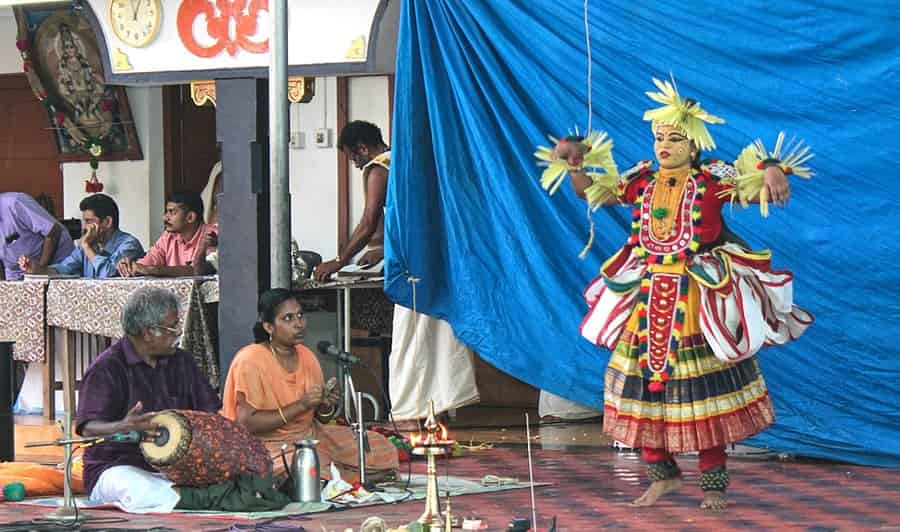
This is very famous dance form of the Kerala State. Within the Kerala state, several various kinds of crafts and arts are performed by the local people such as ritual arts, dance and martial arts. There are numerous types of traditional crafts and arts are still practiced by the artists of the Kerala. This dance form is counted as a performing classical art of the Kerala. You will surely feel your trip of Kerala is worthy after attending the show of Thullal dance. This dance form is performed by the solo artists, with that single dancer, there are 2 musicians are also stand to perform the music. One musician plays the small size cymbals and another one Maddalam. Thullal dance is only presented within the temple’s compound area or else at house’s courtyard. They do not perform on any other stage. The artists who dance, he again sings the song ling which was sung by the assistant musical. To know the meaning of the performance, you don’t need to listens the song with full concentration, just see the facial expression and gestures of the dancers, you will understand the deep meaning of the performance. Their whole body postures and expressions are so elegant and meaningful that you won’t blink your eyes. While the performance, the dancer always change his character from the narrator to the actor.
This is a type of poetry which they explained in the Malayalam language. This poetry is influenced on this form of dance. The dance performance of 2 hours dominates the whole song which is used for the performance. The song which is used in the Thullal dance form is structured on the Naatya Saastra’s classical rules. This song is scripts on the second century’s art. The performer of this dance form explores the musical and impressive footsteps, all these characteristics made the performance unforgettable. The major emotions which they express are anger, humor, pathos, devotion and valor etc, through the way of their tremendous dance. For the bright visuals, they decorate themselves by applying paste of sandal, they wrap the red color cloth over the legs, and over that they tie the white color fabric. The accessories which they use for the performance are necklace and ankle bells etc all this are used to decorate the dancer artist.
Also Read
- Historical Monuments of Kerala
- Best Museums in Kerala to Visit
- Must-See Forts and Palaces in Kerala
- Popular Hill Stations In Kerala
